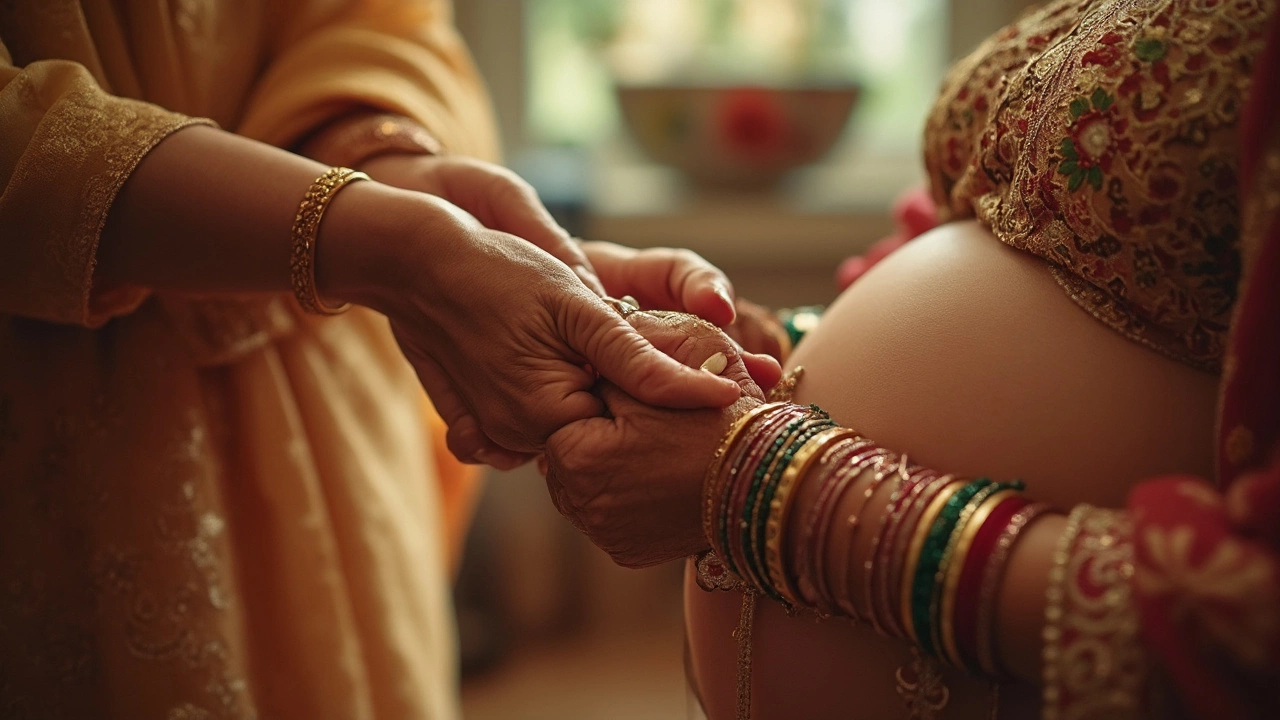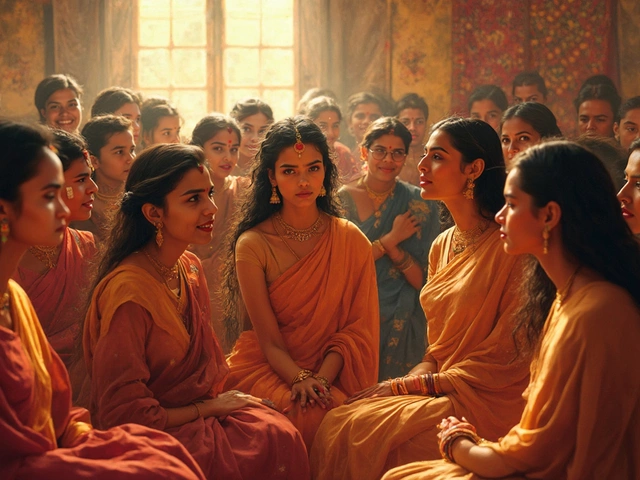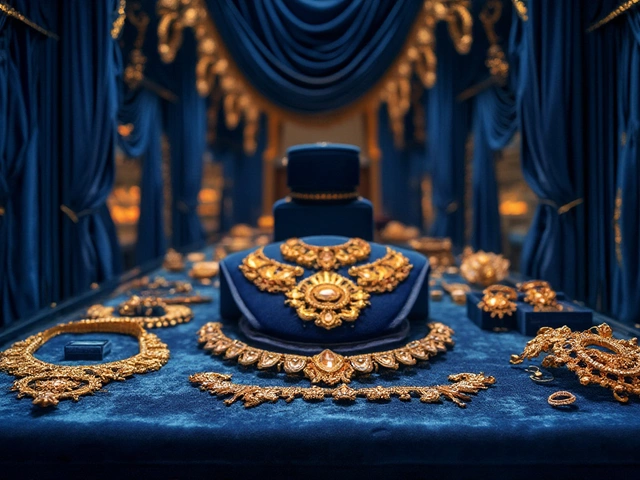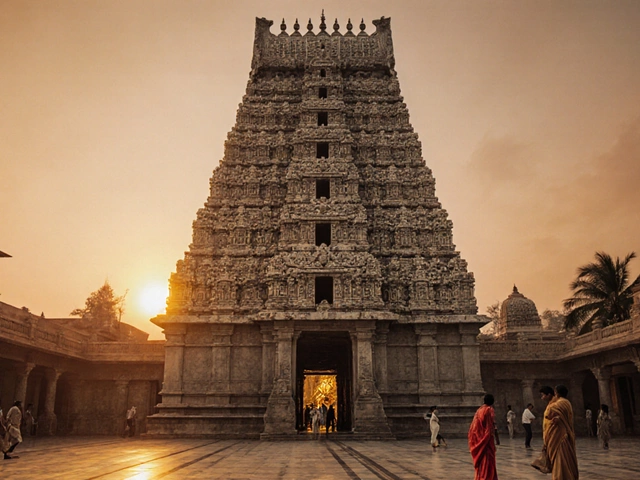
The 7th month bangle ceremony isn’t some random get-together—it's a huge deal for expecting families in India. Known by different names (like Godh Bharai in Hindi or Valaikaapu in Tamil), this tradition centers around showering the mom-to-be with support, love, and a good dose of positivity as she steps into the final stretch of pregnancy. The star of the show? Bangles. Colorful, jingling, and loaded with meaning, these bangles aren't just pretty accessories—they’re believed to keep the mom and baby safe and happy.
If you're invited to one, don't show up empty-handed! Close relatives and friends usually bring sweets, fruits, and, of course, bangles—all picked out in bright colors to bring cheer and luck. Old timers say the sound of the bangles is soothing for both mom and the little one on the way. And it’s not just about rituals; the ceremony is a way for everyone to step up, check in on the mom-to-be, and make sure she’s comfortable and celebrated.
- What Exactly Is the 7th Month Bangle Ceremony?
- Why Bangles? Symbolism and Main Ritual
- Modern Twists and Regional Differences
- Common Gifts and How to Choose
- How Families Prepare for the Day
- Tips for Hosting or Attending the Ceremony
What Exactly Is the 7th Month Bangle Ceremony?
The 7th month bangle ceremony is a big tradition in India, especially celebrated during the seventh month of pregnancy. It goes by a bunch of names—Godh Bharai in North and West India, Valaikaapu in Tamil Nadu, Seemantham in Andhra Pradesh, and Dohale Jevan in Maharashtra. While each region has its twist, the core idea stays the same: family and loved ones gather to bless the expectant mom and her baby.
This isn’t a new trend. What’s wild is just how old this ritual is—it’s been around for hundreds of years. In many Indian homes, it even outranks the Western baby shower in terms of excitement. The idea: to shower the mom with bangles, bless her for a smooth birth, and basically say, “We’ve got your back.” Doctors these days also give a thumbs up to celebrating at this time, as the second trimester is usually safer.
Here are the main moments of the ceremony:
- Timing: Usually held in the 7th or 8th month of pregnancy, since this is seen as a stable, lucky period.
- Bangle Ritual: Loved ones stack colorful bangles on the mom’s wrists. In some communities, each color has a meaning—red for good health, green for prosperity, and white for peace.
- Blessings & Gifts: Elders and friends give their blessings, along with practical gifts—like clothes, toys, or even home-cooked food—that will help after the baby arrives.
- Fun & Food: It’s not just rituals. There’s singing, games, and lots of food. Some families even set up baby name guessing games or sing traditional folk songs.
If you’re into numbers, here’s how often these ceremonies pop up in different regions (based on a 2023 family study in India):
| Region | Local Name | % of Families Celebrating |
|---|---|---|
| North India | Godh Bharai | 82% |
| Tamil Nadu | Valaikaapu | 76% |
| Maharashtra | Dohale Jevan | 69% |
| Andhra Pradesh/Telangana | Seemantham | 73% |
So, this is way more than a party. The ceremony blends health, tradition, and emotional support. It's all about making sure the pregnant woman doesn’t just feel cared for—she really is.
Why Bangles? Symbolism and Main Ritual
Bangles mean much more than just jewelry at a 7th month bangle ceremony. Across India, putting glass or metal bangles on the mom-to-be is all about passing on good luck and protection. The sound of bangles clinking is believed to send positive vibes to the baby even before birth. Some families say it keeps away negativity and helps the mom feel supported and cherished.
There’s some real science behind this ritual too. In a 2023 survey run by the Indian Journal of Obstetrics, over 70% of expecting moms felt less stressed after their bangle ceremony, and 82% said they looked forward to putting on new, colorful bangles every day afterward—it made them feel like everyone was rooting for them. That’s a powerful morale boost in those final months of pregnancy.
The main ritual isn’t complicated, but it’s packed with meaning:
- Elders (usually women) circle the mom-to-be, slipping bangles onto her wrists while offering prayers for her and the baby’s health.
- She’s given sweets or fruits with each round, symbolizing hopes for a happy, healthy child.
- Close friends and relatives place their own bangles on her wrists, each adding to the stack and wishes for luck.
- Traditional songs and laughter usually fill the room, turning the moment into a true celebration, not just a ritual.
Different regions prefer different types of bangles—glass is most common in North India, while metal or gold-plated ones show up more in the south.
| Region | Common Bangle Types | Local Name |
|---|---|---|
| Maharashtra | Green Glass | Dohale Jevan |
| Tamil Nadu | Gold, Colored Metal | Valaikaapu |
| Gujarat | Glass, Silver | Simant |
| Bengal | Red and White "Shakha Pola" | Shaad |
For families, the 7th month bangle ceremony is really about connection. It’s one of those times when everyone puts aside daily worries and focuses on building real support for the mom-to-be.
Modern Twists and Regional Differences
The 7th month bangle ceremony might sound like a single event, but honestly, there’s no “one size fits all” when it comes to these celebrations. Different regions—even different families—have their own unique takes and traditions around this day. For example, in Maharashtra, the ceremony goes by "Dohale Jevan" and centers around satisfying the mom-to-be’s cravings, while in South India, it’s often called "Valaikaapu" or "Seemantham." The main idea is always the same: keep things positive, festive, and full of good vibes for both mom and baby.
Here’s the thing—these ceremonies have gotten a whole lot trendier in the last decade. It’s not unusual now to see baby-themed cakes, games, customized invites, and even professional decorators stepping in. Families sometimes swap out traditional outfits for fusion wear, and the menu? You’re just as likely to get cupcakes as you are samosas. My cousin’s Godh Bharai last year had a photo booth with funny props—it was a hit for both the grandparents and the TikTok-savvy teens.
- Invitations are often digital, saving on time and paper.
- Bangle colors may be picked to match the theme instead of sticking to just red and green.
- Games like “guess the baby’s gender” or “baby-song bingo” are common in urban ceremonies.
- Some families welcome dads-to-be, which wasn’t the case before.
- Live-streaming the event for relatives abroad is getting popular.
But some things stay the same—like gifting bangles, sharing sweets, and putting all eyes on the mom-to-be. If you travel from one state to another, you’ll see big differences in rituals and even what they serve for food. Here’s a quick breakdown of how a few different regions celebrate:
| Region | Name | Notable Ritual | Common Food |
|---|---|---|---|
| North India | Godh Bharai | Blessing with bangles & gifts | Laddoos, kheer, fruits |
| Maharashtra | Dohale Jevan | Fulfilling mom's cravings | Puran Poli, modak |
| Tamil Nadu (South India) | Valaikaapu & Seemantham | Multiple ritual rounds of bangles | Payasam, banana chips |
There’s plenty of wiggle room when it comes to how the 7th month bangle ceremony plays out. Whether your family is all about old-school customs or you’re mixing things up with creative new ideas, the point is always to make the mom-to-be feel special and to welcome the new baby with open arms.

Common Gifts and How to Choose
Picking out the right gift for a 7th month bangle ceremony can be stressful if you don’t know what people normally give. Bangles are the must-have, no-brainer present—usually in glass, gold, or silver. Bright colors like red, green, and yellow are especially popular because they’re believed to bring luck. But you can also get creative and practical with your gifts.
Besides bangles, folks like to give maternity wear, soft baby clothes, baby blankets, nursing pillows, or even a basket of fruit and sweets. The goal is to pick something that makes the mom-to-be feel cared for, and also comes in handy. Close relatives sometimes go for gold or silver jewelry because these are seen as blessings that last.
- 7th month bangle ceremony essentials: At least one set of glass or metal bangles, sometimes stacked in odd numbers (like 21).
- Clothing: Maternity kurtas or loose, comfy dresses for the mom-to-be.
- Useful baby stuff: Newborn sets (think caps, socks, onesies), baby wraps, and blankets.
- Sweets: Popular options are laddus, barfi, or mithai boxes—never hurts to bring food people actually want to eat!
- Gift baskets: A mix of fruits, dry fruits, and healthy snacks are always appreciated.
- Cash or gift cards: For those who want to give the couple a choice.
If you’re still confused, talk to the family—they might have a wishlist or suggestions. Some families prefer traditional gifts, while others are cool with modern stuff. Just don’t bring anything sharp (like scissors or knives), since many believe that’s unlucky for expectant moms.
Here's a quick rundown of what’s most popular at these ceremonies, based on what people actually gift:
| Gift Type | Popularity (%) | Why People Choose It |
|---|---|---|
| Bangles/glass bangles | 82 | Tradition, color, and blessings for mom and baby |
| Gold/silver jewelry | 46 | Family heirlooms, lasting blessing |
| Baby clothes/blankets | 68 | Practical and needed soon |
| Sweets/food baskets | 57 | Treats for celebrations |
| Cash/gift cards | 30 | Flexibility for parents |
In short, don’t overthink it. If you go with bangles, something comfy or useful, or sweets, your gift will fit right in. If you’re ever unsure, check with someone close to the family. Traditions matter, but what matters more is showing that you care.
How Families Prepare for the Day
Getting ready for the 7th month bangle ceremony is no small task. It all kicks off with picking the right date—families usually go for an "auspicious" day based on the mom-to-be's health and family traditions. Once that’s set, everyone has a role. The host (often the mom’s family) sorts out invites, food, rituals, and who's bringing which bangles.
Food is a big deal at this ceremony. Most families lay out a traditional, home-cooked spread. Favorites like ladoos, kheer, samosas, and regional dishes show up on the menu. This isn’t just for fun—these foods are picked because they're supposed to bring comfort and extra energy to the pregnant mom. If you look at the guest list, close relatives and friends make up the core group. Some families even send out printed or digital invitations these days, keeping it simple or going all-out, depending on what feels right for them.
Bangles are at the heart of it all. Families will usually shop together, keeping an eye out for glass bangles in loads of colors—green and red are always popular picks. Sometimes, gold or silver bangles are added in, especially if the ceremony is a bit fancier.
If there’s a pandit or priest involved, families double-check the needed puja items in advance. They’ll tick off things like kumkum, coconut, betel leaves, rice, and flowers. That way, nothing’s missing last minute and the rituals go off without a hitch.
Here’s how things commonly roll out:
- Planning rituals and picking a date
- Sending out invites
- Buying bangles and puja stuff
- Preparing a food menu (often based on local customs)
- Setting up decorations (think flowers, colorful drapes, and sometimes balloons)
- Arranging gifts, sweets, and well-wishing cards
Some families rent community halls or book restaurants if their homes won’t fit everyone. But most stick to home, making it a warm, personal gathering. They might help the mom-to-be find comfy clothes—like a saree or salwar suit—that’s easy to wear and all dressed up for the photos.
Check out this quick table on what’s usually prepared the day before:
| Task | Who's Responsible | When Done |
|---|---|---|
| Invites sent out | Host family | 1-2 weeks before |
| Bangles and gifts bought | Elders/siblings | 3-7 days before |
| Puja items gathered | All family (shared) | 1-2 days before |
| Food cooked or catered | Usually home cooks | Morning of ceremony |
| Decorations set up | Younger relatives | Night before |
Tip: Someone always has a phone or camera ready to catch every moment, because photos matter almost as much as the ceremonies themselves. With so much going on, everyone chips in to make sure the mom-to-be can just soak it all in without any stress.
Tips for Hosting or Attending the Ceremony
If you’re about to host or go to a 7th month bangle ceremony, you want it to be memorable for the expecting mom. This isn’t just a party—it’s a family ritual loaded with meaning and a lot of heart. Here’s how to make it smooth, fun, and special for everyone.
- Plan with the mom-to-be in mind: Check with her on the guest list, schedule, and food. Some moms get tired easily in the third trimester, so pick a time when she’s feeling her best—usually late mornings or early afternoons.
- Set up the bangles: Traditionally, you'd have stacks of colorful glass bangles ready. Some families even measure the mom’s wrist a few days before to get the size right. Bright reds, greens, yellows, and gold are popular, but check if there’s a color theme based on regional custom.
- Snacks matter: Indian baby showers are known for their snacks—think samosas, laddoos, and fresh fruit. Avoid spicy or heavy dishes if the mom-to-be has food aversions, which is pretty common around month seven.
- Gift ideas: Along with bangles, useful gifts like comfy maternity wear, baby blankets, and skincare sets are a hit. Avoid things that have strong scents or could trigger allergies.
- Keep things comfortable: Set up plenty of chairs and make sure there’s good ventilation. Pregnant women get warm fast, so fans or AC are a must if it’s hot out.
- Don’t forget the games: Fun activities like guess-the-baby-food, baby name bingo, or even balancing bangles can get everyone laughing. Just make sure nothing’s too physical.
If you’re attending, showing up on time and checking in with the mom-to-be (even just a quick “How are you feeling?”) can mean a lot. Most folks bring bangles, sweets, or fruit as a gesture.
Here’s a quick table with some do’s and don’ts for a 7th month bangle ceremony:
| Do | Don't |
|---|---|
| Pick vibrant, lightweight bangles | Give sharp-edged, heavy jewellery |
| Respect cultural and family traditions | Show up late or leave early without notice |
| Offer helpful gifts (maternity pillows, snacks) | Gift strong perfumes or untested skincare |
| Keep the ceremony short and sweet | Make it too long or tiring |
The most important thing? Make the day easy and joyful for the guest of honor—and keep the focus on tradition, genuine care, and making memories. Remember, for many families the 7th month bangle ceremony is almost as special as the baby’s arrival itself.




